












|
 |
 |
Before
Susan Allen’s research, scientists believed that most spouses
would share the same HIV status. But her work with couples in Africa
showed that 14% of women tested were in an HIV “discordant”
relationship, where one partner is positive and the other negative.
Allen’s research group, the longest-standing and largest heterosexual
HIV-discordant couples’ cohort in the world, is developing
prevention strategies tailor-made for couples in Rwanda and Zambia. |
 |
| |
|
|
| |
A
Belgian physician, Nathan Clumeck, passing through the city in 1984
sent young pathology resident Susan Allen on what would become the
long, strange trip of her life.
In San Francisco, Allen was spending
long days conducting autopsies on young gay men who had wasted away
and died of a combination of unusual diseases. When Clumeck visited,
he told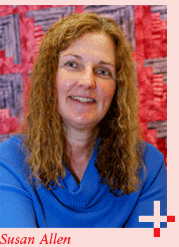 baffling stories of his own. Young Africans in his infectious disease
clinic in Brussels were dying of typically curable tropical diseases.
baffling stories of his own. Young Africans in his infectious disease
clinic in Brussels were dying of typically curable tropical diseases.
“This sounded so much like what
we were seeing in San Francisco—young, healthy people dying
at a 100% rate of diseases that shouldn’t have been lethal,”
says Allen, a professor at the Rollins School of Public Health (RSPH)
since 2004 and a member of Emory’s Center for AIDS Research.
“The only difference was that the Africans were heterosexual,
both men and women, and presenting with different diseases.”
Indeed the diseases affecting Clumeck’s patients and the emerging
epidemic in the United States turned out to have the same cause,
HIV, which led inevitably to AIDS.
In record time, Allen hammered out
150 applications to foundations to explore what was thought to be
an emerging tropical disease. She received funding for four along
with money from the state of California, which was spending more
money on AIDS than the federal government at the time. The grants
were Allen’s ticket back to the developing world where she
was born and raised.
The timing and circumstances fit:
She spoke fluent French, she had a diploma from the Liverpool School
of Tropical Medicine in England, and Rwanda had no pathology labs
or pathologists. Allen offered to set up a laboratory and run it,
and the Rwandans accepted, marking the birth of Projet San Francisco
in 1986.
Over the past 15 years, that program
has evolved into the Rwanda Zambia HIV Research Group (RZHRG), one
of the most successful and prolific in Africa. Founded and directed
by Allen, it now has headquarters at the RSPH and continues to grow
in size and scope. Along with colleagues on the ground in Africa,
Allen employs 15 public health student interns who analyze data
and work on the front lines in Rwanda and Zambia. Her husband, Eric
Hunter, also works on the AIDS front and is professor of pathology
and laboratory medicine in the Emory School of Medicine and a Georgia
Research Alliance Eminent Scholar. |
|
| |
|
|
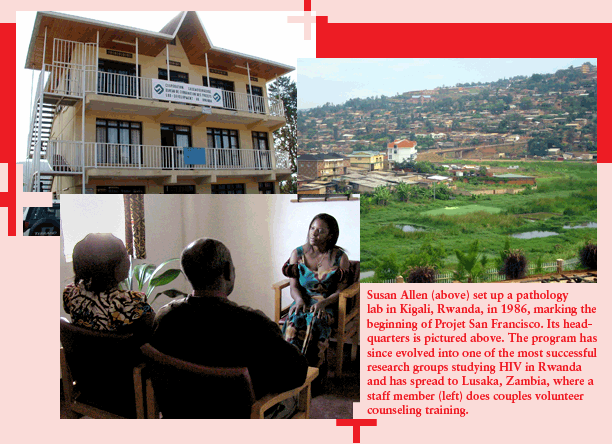 |
| |
|
|
| |
|
|
| |
Point
of
contact |
|
| |
|
|
| |
Just
a year after a test for HIV became available, Allen established
a mobile HIV testing site in 1986 in Kigali, Rwanda, the first of
its kind on the African continent.
Initially, researchers tested nearly
4,000 pregnant women visiting prenatal care clinics. “Women
getting prenatal care are a convenient sample because they are usually
healthy people who represent the general population, and they willingly
seek care,” says Allen. “Unlike most of the people you
see in the medical system, they are not sick.” In the first
year of screening for malaria and HIV, the researchers found an
alarming 29% of the women had positive antibody test results for
AIDS.
“We were stunned,” Allen
says. “We had no idea.”
At first, Allen and her coworkers
hoped HIV would be similar to hepatitis B. “This test detects
antibodies, an immune response to infection,” she says. “And
most people who get viral infections such as hepatitis B get over
it and clear the infection. Although they don’t have virus
anymore, they do have antibodies in their blood.”
However, back in the United States,
the epidemiology showed a darker development. HIV could lie dormant
for many years before a person got sick, and the eventual outcome
was death.
In the shadow of emerging scientific
facts, developing culturally appropriate counseling messages for
Rwandan women was a large challenge. Adapting counseling messages
from those developed in California, Allen’s group taught the
women to use condoms to avoid infection if they were HIV negative
or to avoid infecting their husbands if they were HIV positive.
Although condoms were a popular contraceptive in Asia, they were
almost unknown in Africa at the time.
Allen realized that her Rwandan cohort
could help develop prevention strategies tailor-made for Africa.
Testing in Kigali had identified 1,458 HIV-positive and HIV-negative
women, a large group of study participants who could help the researchers
trace the natural history of HIV over time and devise a way to reduce
risk of transmission. |
|
| |
|
|
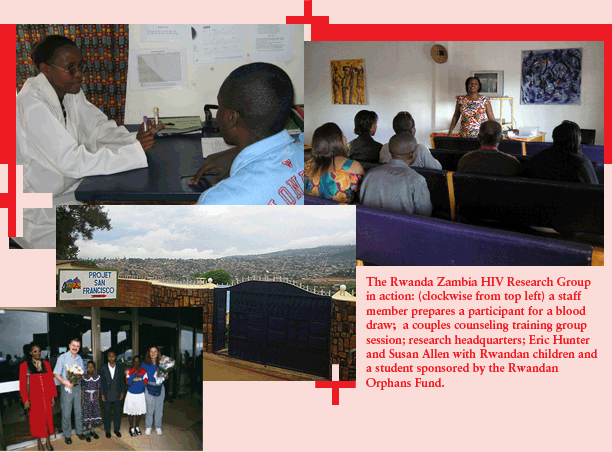 |
| |
|
|
| |
|
|
|
The
couples
approach |
|
| |
|
|
| |
By
1988, the women who participated in the testing consistently were
asking that their spouses be tested as well. Most of the men were
more than willing, and these tests revealed yet another surprise
for AIDS researchers worldwide: 14% of the women tested were in
an HIV “discordant” relationship, where one partner
is positive and the other negative.
“These results were big news,”
Allen says. “Before this study, scientists believed spouses
would share the same HIV status.”
The RZHRG now follows the longest-standing
and largest heterosexual HIV-discordant couples’ cohort in
the world. Once the group began testing both husbands and wives,
it became evident that both partners needed to know the other’s
HIV status to protect themselves from HIV.

Counseling tailored specifically to
the status of each individual couple (both HIV negative, both HIV
positive, or HIV discordant) became the foundation of the couples’
voluntary counseling and testing (CVCT) method, which has proved
successful in Rwanda.
The Zambia–Emory HIV Research
Project (ZEHRP) in Lusaka maintains the world’s second largest
cohort. Like the Rwandan model on which it is based, the site in
Zambia promotes CVCT as a method of HIV prevention and as an entry-point
into HIV clinical care, including prevention of mother-to-child
transmission and antiretroviral therapy programs. ZEHRP has three
satellite clinics in the surrounding districts of the capital city
and one mobile clinic in addition to the main site.
In 2004, a third CVCT research site
was opened in the northern Copperbelt region of Zambia. Although
smaller than its two sister sites, Ubumi Bwesu-ZEHRP is an integral
part of the research. |
|
| |
|
|
| |
|
|
|
Involving
husbands |
|
| |
|
|
| |
The
refinement of testing and counseling techniques is still a work
in progress, but it has come a long way since voluntary testing
and counseling began in the United States. In adapting counseling
messages for use in Rwanda, researchers told the women the virus
was transmitted sexually and through contact with blood. They advised
those tested to use condoms and to refrain from conducting traditional
scarification without sterilized razors.
Almost immediately, the women raised
a red flag. “They told us our condom demonstration was great
but that they couldn’t just go home and tell their husbands
to use them,” Allen says. They asked if they could bring their
husbands in to talk with the counselors.
When husbands were invited to join
the study, approximately one-third came in for free test results
without additional incentives such as money or transportation. In
the process, researchers discovered the existence of HIV-discordant
married couples.
That finding led to another set of
questions: Did the results indicate that the person with the positive
test was infected a long time ago and was no longer highly contagious
when he or she met this spouse? Or was the virus less easily transmitted
than researchers originally thought? And what were the best ways
to ensure the healthiest outcomes for both partners and their children?
The discordant-couples studies aimed to answer these questions about
heterosexual transmission of HIV.
Because the researchers wanted
to trace what happens during transmission, they chose to focus on
discordant couples. From 1992 onward, the group required couples
to be tested together and to sign a joint consent form agreeing
to be in the room together when the results were disclosed and to
discuss them as a couple. |
|
| |
|
|
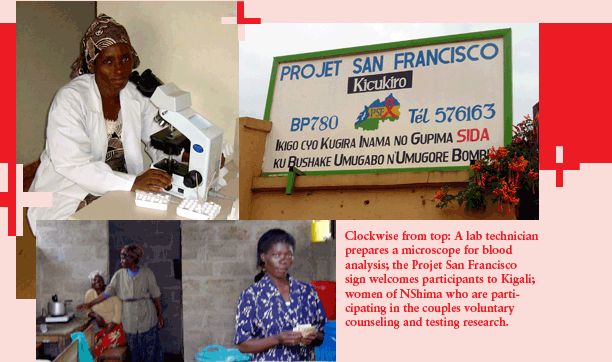 |
| |
|
|
| |
|
|
|
The
impact of
genocide |
|
| |
|
|
| |
In
the Rwandan genocide of 1994, Allen’s original study cohort—along
with the ethnic Tutsis, the economy, the political system, and,
indeed, the fabric of the country—was nearly destroyed. All
the members of Allen’s group who were able fled. Most of the
rest died.
“When the Rwandan president’s
plane was shot down, I was actually in Zambia trying to help them
get HIV testing up and running there,” says Allen. “I
was pregnant and I had left my 13-month-old son behind in Kigali.
When everything hit the fan, I tried to get back, but no one would
fly into Kigali. I sweated it out for five or six days until I found
out my son was alive and had gotten out with an overland convoy
with his dad and others who had been staying in our house. It was
very scary.”

Allen waited a few weeks to see if
the situation would calm down and to find out what was happening
to the rest of their staff. “When it became apparent things
weren’t calming down anytime soon, we had two choices,”
she says, “to terminate and give the rest of the grant money
back or try to find a new place to work. Since I had just come back
from Zambia and met the AIDS community down there, I flew back and
approached the ministry of health and said we’d like to relocate
our research base. They were very supportive.”
When the genocide ended, Allen returned
to Rwanda to put something back together. Half the staff had been
killed, and the study participants were scattered. It took several
years to find out what happened to many of these people and to convince
funding agencies that Rwanda was stable enough for research. From
1994 to August 2001, the project operated on a shoestring. Then
in 2001, Allen’s group received a grant from the World AIDS
Foundation followed by NIH grants in 2002. The International AIDS
Vaccine Initiative became interested in building up the discordant-couples
cohorts again.
“Now we’re bigger than
we were when the genocide began,” says Allen. “We’ve
got about 1,000 discordant couples enrolled in Rwanda, a vaccine
laboratory has been built, and we’ve recently started our
first HIV vaccine trial. Interestingly, one piece of the vaccine
was derived from the virus of a Rwandan man in one of our studies
in 1992. We can tell the president and people of Rwanda that their
participation in HIV research 13 years ago has brought us to the
point where there’s a vaccine product.”
Also, either because of population
shifts after the genocide or education and behavior change, HIV
prevalence among pregnant women in Kigali has dropped to 15% from
29% in 1986. |
|
| |
|
|
| |
 Finding
a way Finding
a way |
|
 |
|
 |
 |
During
three years in the Peace Corps in Benin, Joe Barker saw the
devastation of the AIDS epidemic firsthand. He knew he wanted
to help, and he found a way through an internship with the
Rwanda-Zambia HIV Research Group (RZHRG).
“Working for RZHRG has
given me a sense of the importance of effective research and
how it directly affects, creates, and sustains program interventions,”
says Barker, an MPH student who spent the summer of 2005 at
Projet San Francisco,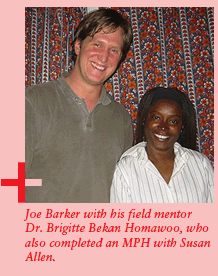 RZHRG’s site in Kigali, Rwanda. His field study, supported
by the Anne E. and William A. Foege Global Health Fund, taught
Barker the nitty-gritty of managing clinical trials, from
coordinating budgets and personnel to administering grants.
He also learned about the basic science of HIV transmission
among African couples, and he conducted primary research on
their comprehension of and motivation to participate in clinical
trials, which will be the basis of his thesis.
RZHRG’s site in Kigali, Rwanda. His field study, supported
by the Anne E. and William A. Foege Global Health Fund, taught
Barker the nitty-gritty of managing clinical trials, from
coordinating budgets and personnel to administering grants.
He also learned about the basic science of HIV transmission
among African couples, and he conducted primary research on
their comprehension of and motivation to participate in clinical
trials, which will be the basis of his thesis.
“I now understand that
collecting good data in developing countries is no small feat,”
says Barker.
He is co-author of two manuscripts
with Susan Allen that use a cohort that he and another student
defined. They gathered demographic information about couples
enrolling in studies in Kigali and Lusaka, Zambia, examining
the effects of alcohol use on condom use among male partners
in HIV-discordant couples.
Barker says RZHRG is a prime
example of local empowerment and culturally appropriate public
health interventions. “It is certainly not a primarily
American or European project. Many of the senior staff and
all the lab technicians, nurses, counselors, and administrative
staff are either Rwandan or Zambian,” he says. “Dr.
Allen emphasizes the importance of training and collaborating
with local experts and scientists. Witnessing a non-ethnocentric
approach toward the HIV epidemic was one of the most important
lessons I gained.”
After graduation, Barker hopes to
spend two years in Kigali coordinating a phase III randomized
control trial studying HIV/HSV-2 transmission. He says he
feels incredibly lucky. “I was looking for a truly international,
grass roots organization doing powerful public health work,
and I found it.” |
 |
| |
|
|
|
|
| |
|
|
| |
|
|
|
|
|
|



